What would a farming-related newsletter be without discussing the weather, especially during the spring? So far, this spring has not disappointed in varying degrees of drastic weather conditions. Daytime highs have ranged from the 40s to the 80s. While upper soil profile moisture conditions have varied, the lower soil profiles have generally remained dry. This reminds us that we never recharged the soil moisture from last year's fall harvest. Here's a look from last fall to mid-April.
Another aspect of the weather worth mentioning is the WIND. If you are thinking that it seems windier than it used to, you are correct. The graph below illustrates how windy East Central Illinois has been during the last 30 years, with only 1996 being windier than 2024. However, we have seen a trend since 2020 of windy conditions increasing each year and current cropping practices may need addressed. Many of the original conservation practices from the 1930s are still in practice today, but maybe it's time to rethink some tillage practices to avoid issues with loss of topsoil from these windier areas.
These pictures show worst-case scenarios that I think we can all agree the industry should work to avoid.


A few items to consider as we continue this spring:
- Is the tillage pass necessary to complete planting?
- Is there a better tool for the job?
- What conservation practices could be implemented?
Beyond the concerns with tillage and windy conditions, what about nutrient and pesticide applications? Are those applications reaching the desired target? We have seen new legislation on pesticide labels to address off-target movement of pesticides beyond dicamba and 2,4-D. As new labels are developed, you will see more requirements for considering wind speeds at the time of application. New legislation has also been introduced to address off-target movement around schools, parks, bike trails, and home daycares.
Last year in April, there was a lot of scrutiny from local environmental groups after they followed around applicators and sprayers trying to make examples and then pressuring the IL Department of Ag to administer fines. Beyond the motivation to avoid public scrutiny from local environmental groups and becoming news headlines, what about the loss of goods and services when applying inputs in windy conditions? One thing I often notice is that when the spinner bed fertilizer applicator shuts down due to windy conditions, I still see air flow machines running. I realize these machines have a wider range of operations, but often it seems as if this gives operators a false sense of appropriate operating conditions. Below is my recommendation for the ag retail community – including the FS Growmark system, of which Illini FS is a part of – and local growers.
- Read and follow pesticide labels and understand wind limitations.
- Understand best management practices for sprayers and nutrient applicators concerning windy conditions.
- Growers and/or ag retail should avoid pressuring applicators to make applications in less-than-ideal conditions.
- Applicators should stay aware of changing weather conditions and avoid less than ideal conditions.
- Good documentation of both pesticide and nutrient applications is key if applications are ever questioned due to adverse windy conditions.
In an era where nearly everyone has a cell phone camera within arm's reach, I ask everyone to avoid making decisions that might result in a news headline or social media post during what seems like a windier season in Illinois. If growers or readers of this newsletter have questions or concerns about management strategies for this year, Illini FS or I would welcome the opportunity to partner with you. If readers want to contact me personally, please utilize my contact information below.
 Eric Beckett, CCA 4RNMS
Eric Beckett, CCA 4RNMS
Field Agronomist, Illini FS
217-318-9100




 and then
and then